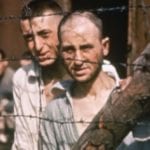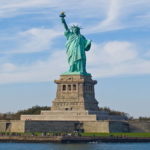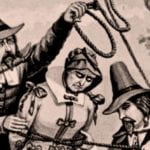 Technology
Technology  Technology
Technology  Humans
Humans 10 Everyday Human Behaviors That Are Actually Survival Instincts
 Animals
Animals 10 Animals That Humiliated and Harmed Historical Leaders
 History
History 10 Most Influential Protests in Modern History
 Creepy
Creepy 10 More Representations of Death from Myth, Legend, and Folktale
 Technology
Technology 10 Scientific Breakthroughs of 2025 That’ll Change Everything
 Our World
Our World 10 Ways Icelandic Culture Makes Other Countries Look Boring
 Misconceptions
Misconceptions 10 Common Misconceptions About the Victorian Era
 Mysteries
Mysteries 10 Strange Unexplained Mysteries of 2025
 Miscellaneous
Miscellaneous 10 of History’s Most Bell-Ringing Finishing Moves
 Technology
Technology Top 10 Everyday Tech Buzzwords That Hide a Darker Past
 Humans
Humans 10 Everyday Human Behaviors That Are Actually Survival Instincts
 Animals
Animals 10 Animals That Humiliated and Harmed Historical Leaders
Who's Behind Listverse?

Jamie Frater
Head Editor
Jamie founded Listverse due to an insatiable desire to share fascinating, obscure, and bizarre facts. He has been a guest speaker on numerous national radio and television stations and is a five time published author.
More About Us History
History 10 Most Influential Protests in Modern History
 Creepy
Creepy 10 More Representations of Death from Myth, Legend, and Folktale
 Technology
Technology 10 Scientific Breakthroughs of 2025 That’ll Change Everything
 Our World
Our World 10 Ways Icelandic Culture Makes Other Countries Look Boring
 Misconceptions
Misconceptions 10 Common Misconceptions About the Victorian Era
 Mysteries
Mysteries 10 Strange Unexplained Mysteries of 2025
 Miscellaneous
Miscellaneous 10 of History’s Most Bell-Ringing Finishing Moves
Ten Foreboding Preludes to the Holocaust
Like any historical tragedy, the Holocaust can only be viewed in hindsight, and its gruesome totality—11 million dead, six million of them Jewish—often makes attempts to understand its perpetrators’ actions and rationales seem perverse, even insulting. An argument can be made that only pure evil can cause such an immense manmade disaster, and that explaining the buildup to these widespread war crimes only humanizes the inhuman, genocidal path the criminals chose.
That is, I assure you, not my intention here. Only by studying the prelude to disasters can we prevent repeating such atrocities. Following are ten steps leading to the worst mass murder in human history.
Related: Top 10 Incredible People Who Were Heroes Of The Holocaust
10 U.S. Immigration Quotas
Between 1880 and 1914, at least 7.5 million people from Eastern Europe migrated to the United States, part of the “second great wave” of immigration that saw more than 25 million come to America. By 1900, New York City’s Lower East Side—home to about 500,000 mostly newly arrived Jews—teemed with over 700 people per acre, making it the most densely populated neighborhood in the world.
In what rhymes with today’s overblown “replacement theory” concerns, many white, primarily Protestant Americans began to worry about being overrun and outvoted by the flood of Roman Catholics and Jews arriving annually. Many also expressed concern about foreign-born diseases spreading in the immigrants’ typically cramped, impoverished living conditions, as well as the driving down of worker wages given the glut of largely unskilled laborers.
So in May 1924—well before Hitler came to power or the Great Depression prioritized economy-preserving measures—the U.S. passed into law a quota system setting strict limits on immigration from Eastern and Southern Europe. These laws, along with a general anti-immigration public sentiment, would play a pivotal role by blocking a critical potential landing place for persecuted Jews over the next two decades.
By the time European Jews most needed refuge, immigration quotas stemmed their flow from a flood to a trickle. By 1938, some 300,000 desperate, overwhelmingly Jewish people from Germany alone applied for U.S. immigration. Just 20,000 were accepted.[1]
9 The Great Depression
The Holocaust almost certainly wouldn’t have occurred had there been no worldwide depression because the widespread economic meltdown was crucial to the rise of Adolf Hitler.
As the October 1929 Wall Street stock market crash sent economic shockwaves around the globe, German industry began to unravel—quicker than most, as the country’s economy was still recovering from World War I. Germany’s unemployment rate surged from a healthy 4.5% in 1929 to 24% by 1932.
New elections were called for 1930 after attempts to pass economic aid hit an impasse. Scapegoating Jews and communists, Adolf Hitler, who just six years earlier had served nine months in jail for treason after attempting to overthrow the government, led his National Socialist German Workers’ Party, aka Nazi, to a strong second-place showing, winning 107 seats in the Reichstag—an astounding 95-seat gain.
With his antisemitic diatribes intensifying among an increasingly impoverished populace, Hitler ran for president in 1932. A desperate and, therefore, impressionable public heard him vow to place Germans first, blaming Jews and other peoples deemed insufficiently German for exacerbating economic hardship. Campaigning by airplane with the ominous double entendre slogan of “Hitler über Deutschland ” (“Hitler over Germany”), he placed a strong second to incumbent Paul von Hindenburg.
Despite deep hesitations, on January 30, 1933, von Hindenburg appointed Hitler as chancellor to help form a more governable coalition. Ironically, given von Hindenburg’s infamous dirigible namesake, his government would soon crash and burn.[2]
8 The Reichstag Fire
German president Paul von Hindenburg should have listened to his gut. He knew Nazi party leader Adolf Hitler was dangerous, but nonetheless gave him penultimate power by appointing Hitler chancellor.
A month later, on February 27, passersby heard glass shattering at the Reichstag, the seat of Germany’s government. Fire soon erupted, gutting the building’s grand cupola and main chamber. With suspicious efficiency, police arrested a 24-year-old Dutch immigrant with communist sympathies at the scene.
Whether or not the incident was a Nazi-directed false flag operation remains unclear. What’s crystal clear is it was exactly the catastrophe an opportunist like Hitler needed to sweep away all remaining opposition.
Moving quickly, Hitler orchestrated the innocuously named Decree for the Protection of the People and the State. Echoing post-disaster legislation in democracies throughout history, the law rescinded and restricted individual rights. In the name of safety, the right to assembly was suspended, as was free speech and freedom of the press. The act also removed restraints on police investigations, allowing Hitler to indefinitely jail political opponents—immigrants, communists, and, especially, Jews.
The die had been cast. Touted as the Fatherland’s grand savior, Germany’s parliament granted Hitler near-total control in March. By year’s end, all non-Nazi political parties and labor unions went kaput. And when von Hindenburg died the following year, Hitler amalgamated the offices of president and chancellor. He was now the Führer—Germany’s unchecked authoritarian ruler.[3]
7 “Kauft Nicht bei Juden”: Marginalizing the Jews
Upon gaining absolute power, Hitler wasted little time segregating Jews from mainstream society.
In 1935, the so-called Nuremberg Laws institutionalized several racist notions prominent in Nazi ideology. Jews were disenfranchised, stripped of citizenship, and barred from marrying persons of “German or German-related blood.” Jews were expelled from the army and unable to become doctors. Steadily, individual regions passed even harsher rules; for example, in Düsseldorf, Jews were no longer accepted at municipal hospitals.
Next came economic ruin. Germany ordered government agencies and prominent companies to undergo a full-scale “Aryanization.” Jews were fired as managers and workers, and major Jewish-owned enterprises were transferred to non-Jews. By 1938, Jewish-owned businesses were reduced by two-thirds.
Following a brief respite in 1936—Germany was hosting both the Summer and Winter Olympics and wanted to show a tolerant face to an increasingly skeptical international community—persecution of the Jews regained steam. Starting in 1937, Jews were required to register their property with the government, an obvious preclude to widescale confiscation. Government-endorsed boycotts of Jewish businesses proliferated.
During the first six years of his rule, Hitler enacted over 400 decrees regulating all aspects of Jewish lives. As the Nazis gobbled up territory—Austria, part of Czechoslovakia, Poland—his fiats held sway over more and more Jews (Poland alone had 3.3 million).
But as his Reich grew, Hitler came across an intractable problem: There were too many Jews merely to marginalize.[4]
6 A Convenient Assassination: Kristallnacht
One event in particular punctuated, exacerbated, and expedited Nazi persecution of the Jews: Kristallnacht, the Night of Broken Glass. This aptly named event saw shattered glass littering streets throughout Germany and other Nazi-held territories following the vandalism and destruction of Jewish-owned businesses, synagogues, and homes.
Operating straight from a dictator’s playbook, Hitler used a minor dustup to foment major anti-Jewish attacks. On November 7, 1938, a 17-year-old Polish-German Jew named Herschel Grynszpan entered Germany’s embassy in Paris. Upon learning his parents had been deported from Germany to Poland (which hadn’t yet been invaded by the Nazis), Grynszpan shot and killed a German embassy official, Ernst vom Rath.
Hitler’s maniacally unmeasured response was to unleash a full-blown pogrom against Jews, disguised as spontaneous, civilian-conducted responses to the murder of a low-level embassy official. These “responses” were, in fact, government-sanctioned purges. Declaring that “World Jewry” had conspired to murder vom Rath, propaganda minister Joseph Goebbels announced that while “the Führer has decided that… demonstrations should not be prepared or organized by the Party, [if] they erupt spontaneously, they are not to be hampered.”
What ensued was devastation and, crucially, escalation. In addition to millions of dollars in damage, approximately 30,000 Jewish males were arrested and sent to then-nascent concentration camps—the first instance of mass arrest justified strictly by Jewishness. Hitler also imposed a billion-Reichsmark “atonement tax” on the Jewish community as restitution for the destruction of infrastructure—another prelude to widespread property confiscation.[5]
5 Shunned at Sea: The MS St. Louis
One high-profile incident showcased what antisemitic policies on both sides of the Atlantic had sown. It exemplified how a put-open, imperiled people forced to flee their homeland often found nowhere else to go.
In May 1939, the German liner, the MS St. Louis set sail from Hamburg, Germany. Its 937 passengers, nearly all Jewish, were but a fraction of those fleeing Germany after events like Kristallnacht supercharged antisemitism and hastened Jewish flight.
The MS St. Louis steamed west across the Atlantic, bound for the historically welcoming island of Cuba. But while all passengers held visas to resettle in the Caribbean country, Havana’s political landscape shifted drastically during their voyage. Cuba’s president, Federico Laredo Brú, refused to accept the foreign refugees and soon ordered the ship to leave.
Adrift and aimless, the St. Louis wandered north. Near the Florida coast, Captain Gustav Schröder considered running the ship ashore so refugees could escape; the U.S. Coast Guard—on orders from the State Department—tailed the ship to prevent this. Canada followed suit, refusing safe harbor.
Back across the Atlantic went the St. Louis. Finally, several Western European countries agreed to divide them up. Almost 300 settled in England, over 200 apiece in France and Belgium, and nearly 200 in The Netherlands.
Of course, Hitler eventually invaded all but England. Unsurprisingly and unforgivably, 254 of the ship’s 937 passengers eventually died in the Holocaust.[6]
4 Go East, Young Nazi
Germany’s three initial conquests—annexing Austria and parts of Czechoslovakia before igniting World War II with the September 1939 invasion of Poland—were indicative of Hitler’s long-term ambitions. “Our colonial territory,” Hitler professed, “is in the east.” As the Reich pushed eastward, Germany initiated what historians call “settler colonialism,” in which an area’s original inhabitants are exploited and replaced by its conqueror’s people.
For Hitler, occupying the nations west of Germany was a mere military necessity; his invasion of Poland led France and Great Britain to declare war, requiring Germany to deal with two powerful neighbors. Still, Hitler was so dead set on eastward expansion that, eventually, he made a fatal mistake: Rather than overrun England in the wake of France’s fall, Hitler invaded the expansive Soviet Union in June 1941.
As it pushed east past Poland and its 3.3 million Jews, Nazi Germany continued to seize lands with high Jewish populations. As he did so, Hitler often cited what he saw as a promising precedent for dealing with them: the United States’ destruction of Native American peoples during its 19th-century westward expansion.
All the echoes were there: A mighty Anglo-Saxon invader capturing land on its own continent, clearing out indigenous people to make space—”Lebensraum,” as the Nazis called it—for racially superior settlers. Given the combined six million Jews in Poland and the USSR, compared to just 525,000 in prewar Germany, simply sweeping aside the Jews would no longer suffice.[7]
3 Like Cattle: Concentration Camps & Ghettos
All this was a steady, gradual build toward the systematic displacement and imprisonment of Jews through Nazi-controlled areas into impoverished slums and, increasingly, labor camps. While Jews were confined to concentration camps as early as 1934, the practice didn’t proliferate in earnest until the late 1930s. Like any horrific institution, it grew as it became more normalized—and, per the previous entry, as millions more Eastern European Jews came under the Reich’s aspiring empire.
The invasion of Poland was a demarcation line. Soon after, camps with the most notorious names would open, including Auschwitz in 1940 and Treblinka in 1941. Many were established near factories or sites designed to extract raw materials. The goods and substances produced by prisoner labor were sold to Nazi-owned companies, enriching coffers while enhancing Germany’s war machine.
Always the flow of Jews into work camps was always kept steady. Nazis accomplished this by herding Jews into walled ghettos, most infamously in Warsaw. There, more than 90,000 Jews died from disease and starvation while assumedly waiting for deportation to a camp.
By the war’s end, as many as 44,000 concentration camps were established, including those whose primary function would be mass killing via gas chambers. By most accounts, the first instance of en masse gas chamber murder was in September 1941, when hundreds of Soviet prisoners of war were executed at Auschwitz. Soon, the terrible efficiency would be exponentially multiplied to kill millions of mostly Jewish detainees.[8]
2 U.S. State Department: Blind Eyes & Bigotry
As the situation in Europe rapidly deteriorated, immigration quotas weren’t the only obstacle hampering desperate Jews’ ability to seek shelter in America. So was a State Department stacked with prejudiced bureaucrats willfully ignoring the unfolding genocide.
Assistant Secretary Samuel Breckenridge Long, who oversaw the Visas Department, was a prime example. Long began his stint in January 1940, six months after the sad spectacle of the MS St. Louis and more than a year after the publicity-grabbing Kristallnacht showcased the Reich-wide antisemitic pogrom.
His tactics were myriad, but his strategy was clear: in a situation that called for swift, decisive action, Long was playing… well, the long game. Claiming Nazi spies would hide among the huddled masses, he imposed lengthy, multilayered vetting processes for any European seeking asylum. In June 1941, he instructed the Visa Division to impose blanket rejections on applications from people with relatives living in the ever-growing territory controlled by Nazis, making it all but impossible for Jewish refugees to come to America.
As the Holocaust gained steam in 1942-43, Long downplayed and disputed news reports of mass murder. When called to testify in November 1943 regarding what measures the U.S. was taking to mitigate the unfolding genocide, Long’s claim of nearly 600,000 Jewish refugees admitted in the past decade was wildly overstated.
In January 1944, his suppression of information concerning the Nazi slaughter was discovered. Long was reassigned and, that November, resigned with his ignominious legacy assured.[9]
1 No Escape: Germany Ends Emigration
October 1941—two months before the U.S. entered World War II—was the beginning of the end for the millions of Jews in Nazi-controlled Europe. Until then, Hitler was happy to have most Jews simply run in fear of his Aryan autocracy. Then, he rescinded emigration almost entirely.
At his reign’s inception, Hitler had no intention to murder some six million Jews. That’s not my opinion, but an assessment offered by no less a pro-Jewish authority than the United States Holocaust Memorial Museum.
It was not until mid-to-late 1941 that Hitler embraced what became known as “The Final Solution,” the systematic extermination of the Jews of Europe. But once that path was chosen, the plan was enacted with zeal. The vast majority of the Jews killed in the Holocaust died in the next, and mercifully last, three-plus years.
The rest is history—horrible, horrible history. With the gas chamber tested successfully on Soviet POWs in September 1941, in 1942-43, some 1.7 million Jews in Poland—more than half its prewar Jewish population—were slaughtered largely in this manner. In Ukraine, another 1.5 million were exterminated, mostly via mass firing squads known as the Holocaust by Bullets.
As the war turned and Nazi troops faded back toward Germany, they took the Holocaust with them, marching emaciated Jews ahead of their tanks and trucks. By Berlin’s fall, two-thirds of the Jews in Europe had been murdered in mankind’s most heinous war crime.[10]








